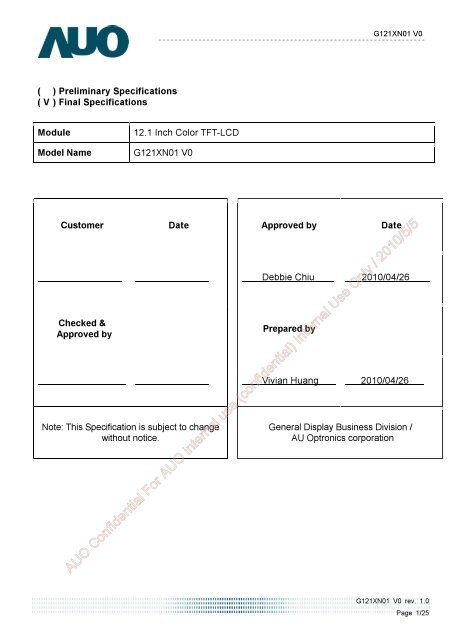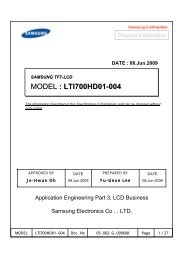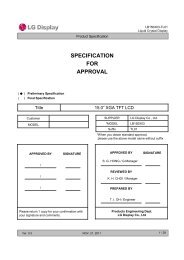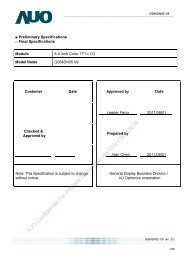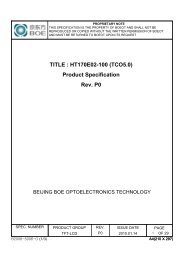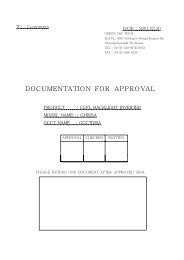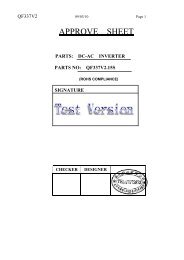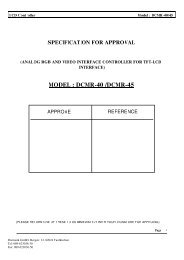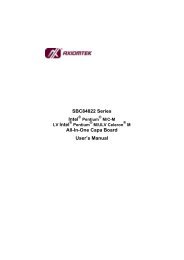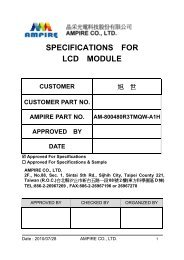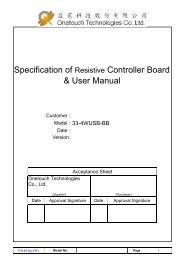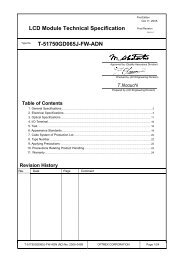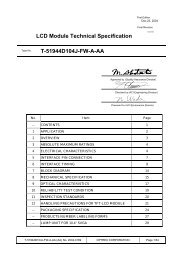AUO Confidential For AUO internal use (confidential) Internal Use Only
AUO Confidential For AUO internal use (confidential) Internal Use Only
AUO Confidential For AUO internal use (confidential) Internal Use Only
Create successful ePaper yourself
Turn your PDF publications into a flip-book with our unique Google optimized e-Paper software.
( ) Preliminary Specifications<br />
( V ) Final Specifications<br />
Module 12.1 Inch Color TFT-LCD<br />
Model Name G121XN01 V0<br />
Customer Date<br />
Checked &<br />
Approved by<br />
Note: This Specification is subject to change<br />
without notice.<br />
G121XN01 V0<br />
Approved by Date<br />
Debbie Chiu 2010/04/26<br />
Prepared by<br />
Vivian Huang 2010/04/26<br />
General Display Business Division /<br />
AU Optronics corporation<br />
<strong>AUO</strong> <strong>Confidential</strong> <strong>For</strong> <strong>AUO</strong> <strong>internal</strong> <strong>use</strong> (<strong>confidential</strong>) <strong>Internal</strong> <strong>Use</strong> <strong>Only</strong> / 2010/5/5<br />
G121XN01 V0 rev. 1.0<br />
Page 1/25
G121XN01 V0<br />
Contents<br />
1. Operating Precautions.....................................................................................4<br />
2. General Description.........................................................................................5<br />
2.1 Display Characteristics...........................................................................................................5<br />
2.2 Optical Characteristics ...........................................................................................................6<br />
3. Functional Block Diagram ...............................................................................9<br />
4. Absolute Maximum Ratings ..........................................................................10<br />
4.1 Absolute Ratings of TFT LCD Module .................................................................................10<br />
4.2 Absolute Ratings of Environment ........................................................................................10<br />
5. Electrical Characteristics ..............................................................................11<br />
5.1 TFT LCD Module ..................................................................................................................11<br />
5.2 Backlight Unit........................................................................................................................13<br />
6. Signal Characteristics ...................................................................................14<br />
6.1 Pixel <strong>For</strong>mat Image ..............................................................................................................14<br />
6.2 Scanning Direction ...............................................................................................................14<br />
6.3 TFT-LCD Interface Signal Description .................................................................................15<br />
6.4 The Input Data <strong>For</strong>mat .........................................................................................................16<br />
6.5 TFT-LCD Interface Timing ....................................................................................................18<br />
6.6 Power ON/OFF Sequence ...................................................................................................19<br />
7. Connector & Pin Assignment........................................................................20<br />
7.1 TFT-LCD Signal (CN1): LCD Connector .............................................................................20<br />
7.2 LED Backlight Unit (CN2): Backlight Connector .................................................................20<br />
8. Reliability Test Criteria ..................................................................................21<br />
9. Mechanical Characteristics ...........................................................................22<br />
9.1 LCM Outline Dimension (Front View) ..................................................................................22<br />
9.2 LCM Outline Dimension (Rear View)(Pin 1 position) ..........................................................22<br />
10. Label and Packaging....................................................................................24<br />
10.1 Shipping Label (on the rear side of TFT-LCD display)......................................................24<br />
10.2 Carton Package .................................................................................................................24<br />
11 Safety.............................................................................................................25<br />
11.1 Sharp Edge Requirements.................................................................................................25<br />
11.2 Materials .............................................................................................................................25<br />
11.3 Capacitors...........................................................................................................................25<br />
11.4 National Test Lab Requirement..........................................................................................25<br />
<strong>AUO</strong> <strong>Confidential</strong> <strong>For</strong> <strong>AUO</strong> <strong>internal</strong> <strong>use</strong> (<strong>confidential</strong>) <strong>Internal</strong> <strong>Use</strong> <strong>Only</strong> / 2010/5/5<br />
G121XN01 V0 rev. 1.0<br />
Page 2/25
Record of Revision<br />
G121XN01 V0<br />
Version and Date Page Old description New Description<br />
0.0 2009/09/14 All First Edition<br />
0.1 2009/12//11 21 LCM outline dimension (Front view) Update mounting help position<br />
22 LCM outline dimension (Rear view) Update pin assignment<br />
0.2 2010/01/08 16 The input data format Update SEL68 input data format<br />
1.0 2010/04/26 5 Typical power consumption: TBD Typical power consumption: 9.15W<br />
5<br />
Temperature Range<br />
Operating : -30 to +80 o C<br />
Storage (Non-Operating): -30 to +80 o C<br />
Temperature Range<br />
Operating : -30 to +85 o C<br />
Storage (Non-Operating): -30 to +85 o C<br />
6 White Luminance condition: IF= 120mA White Luminance condition: IF= 110mA<br />
6<br />
Color / Chromaticity<br />
Coordinates : TBD<br />
Add Min., Typ., Max.<br />
10<br />
Absolute Ratings of Environment<br />
Temperature : Max 80 o C<br />
Absolute Ratings of Environment<br />
Temperature : Max 85 o C<br />
11<br />
LCD Input Current: TBD<br />
LCD Power consumption: TBD<br />
Add Typ., Max.<br />
11<br />
LCD Inrush Current: TBD<br />
Allowable Logic/LCD Drive Ripple Voltage: TBD<br />
Add Max.<br />
12 Differential Input Common Mode Voltage: TBD Add Typ.<br />
13 Parameter guideline for LCD: TBD Add Typ., Max.<br />
15 TFT-LCD Interface Signal Description Add Note 4, Note 5<br />
16 CLK Data Clock frequency 40MHz CLK Data Clock frequency 65 MHz<br />
23 Label and Packaging Add Shipping Label, Carton Package<br />
<strong>AUO</strong> <strong>Confidential</strong> <strong>For</strong> <strong>AUO</strong> <strong>internal</strong> <strong>use</strong> (<strong>confidential</strong>) <strong>Internal</strong> <strong>Use</strong> <strong>Only</strong> / 2010/5/5<br />
G121XN01 V0 rev. 1.0<br />
Page 3/25
1. Operating Precautions<br />
1) Since front polarizer is easily damaged, please be cautious and not to scratch it.<br />
G121XN01 V0<br />
2) Be sure to turn off power supply when inserting or disconnecting from input connector.<br />
3) Wipe off water drop immediately. Long contact with water may ca<strong>use</strong> discoloration or<br />
spots.<br />
4) When the panel surface is soiled, wipe it with absorbent cotton or soft cloth.<br />
5) Since the panel is made of glass, it may be broken or cracked if dropped or bumped on<br />
hard surface.<br />
6) To avoid ESD (Electro Static Discharde) damage, be sure to ground yourself before handling<br />
TFT-LCD Module.<br />
7) Do not open nor modify the module assembly.<br />
8) Do not press the reflector sheet at the back of the module to any direction.<br />
9) In case if a module has to be put back into the packing container slot after it was taken<br />
out from the container, do not press the center of the LED light bar edge. Instead, press<br />
at the far ends of the LED light bar edge softly. Otherwise the TFT Module may be<br />
damaged.<br />
10) At the insertion or removal of the Signal Interface Connector, be sure not to rotate nor<br />
tilt the Interface Connector of the TFT Module.<br />
11) TFT-LCD Module is not allowed to be twisted & bent even force is added on module in a very<br />
short time. Please design your display product well to avoid external force applying to module<br />
by end-<strong>use</strong>r directly.<br />
12) Small amount of materials without flammability grade are <strong>use</strong>d in the TFT-LCD module. The<br />
TFT-LCD module should be supplied by power complied with requirements of Limited Power<br />
Source (IEC60950 or UL1950), or be applied exemption.<br />
13) Severe temperature condition may result in different luminance, response time and lamp<br />
ignition voltage.<br />
14) Continuous operating TFT-LCD display under low temperature environment may accelerate<br />
lamp exhaustion and reduce luminance dramatically.<br />
15) The data on this specification sheet is applicable when LCD module is placed in landscape<br />
position.<br />
16) Continuous displaying fixed pattern may induce image sticking. It’s recommended to <strong>use</strong><br />
screen saver or shuffle content periodically if fixed pattern is displayed on the screen.<br />
<strong>AUO</strong> <strong>Confidential</strong> <strong>For</strong> <strong>AUO</strong> <strong>internal</strong> <strong>use</strong> (<strong>confidential</strong>) <strong>Internal</strong> <strong>Use</strong> <strong>Only</strong> / 2010/5/5<br />
G121XN01 V0 rev. 1.0<br />
Page 4/25
2. General Description<br />
This specification applies to the Color Active Matrix Liquid Crystal Display G121XN01 V0<br />
G121XN01 V0<br />
composed of a TFT-LCD display, a driver and power supply circuit, and a LED backlight system.<br />
The screen format is intended to support XGA (1024(H) x 768(V)) screen and 16.2M (RGB 8-bits)<br />
or 262k colors (RGB 6-bits).<br />
LED driving board for backlight unit is included in G121XN01 V0 and the LED unit is replaceable.<br />
All input signals are LVDS interface and compatible with G121SN01 V3 and G121SN01 V4.<br />
G121XN01 V0 designed with wide viewing angle; wide temperature and long life LED backlight is<br />
well suited for industial applications.<br />
G121XN01 V0 is a RoHS product.<br />
2.1 Display Characteristics<br />
The following items are characteristics summary on the table under 25 condition:<br />
Items Unit Specifications<br />
Screen Diagonal [inch] 12.1<br />
Active Area [mm] 245.76 (H) x 184.32 (V)<br />
Pixels H x V 1024 x 768<br />
Pixel Pitch [mm] 0.24 x 0.24<br />
Pixel Arrangement R.G.B.W Rectangle<br />
Display Mode TN, Normally White<br />
Nominal Input Voltage VDD [Volt] 3.3 (typ.)<br />
Typical Power Consumption [Watt]<br />
9.15(typ.)<br />
All black pattern<br />
Weight [Grams] 495 (Max.)<br />
Physical Size [mm] 279.0(H) x 209.0(V) x 9.0(D) (Max.)<br />
Electrical Interface 1 channel LVDS<br />
Surface Treatment Anti-glare, Hardness 3H<br />
Support Color 16.2M / 262K colors<br />
Temperature Range<br />
Operating<br />
Storage (Non-Operating)<br />
[ o C]<br />
[ o C]<br />
-30 to +85<br />
-30 to +85<br />
RoHS Compliance RoHS Compliance<br />
<strong>AUO</strong> <strong>Confidential</strong> <strong>For</strong> <strong>AUO</strong> <strong>internal</strong> <strong>use</strong> (<strong>confidential</strong>) <strong>Internal</strong> <strong>Use</strong> <strong>Only</strong> / 2010/5/5<br />
G121XN01 V0 rev. 1.0<br />
Page 5/25
G121XN01 V0<br />
2.2 Optical Characteristics Theopticalcharacteristicsaremeasuredunderstableconditionsat25�(RomTemperature):<br />
Item Unit Conditions Min. Typ. Max. Remark<br />
White Luminance [cd/m2]<br />
IF= 110mA/1 LED Line<br />
(center point)<br />
375 500 - Note 1<br />
Uniformity % 5 Points 75 - - Note 2, 3<br />
Contrast Ratio 500 700 - Note 4<br />
Response Time<br />
Viewing Angle<br />
Color / Chromaticity<br />
Coordinates<br />
(CIE 1931)<br />
[msec] Rising - 25 35<br />
[msec] Falling - 10 20<br />
[msec] Raising + Falling - 35 55<br />
[degree]<br />
[degree]<br />
[degree]<br />
[degree]<br />
Horizontal (Right)<br />
CR = 10 (Left)<br />
Vertical (Upper)<br />
CR = 10 (Lower)<br />
Red x 0.592 0.642 0.692<br />
Red y 0.292 0.342 0.392<br />
Green x 0.276 0.326 0.376<br />
Green y 0.565 0.615 0.665<br />
Blue x 0.098 0.148 0.198<br />
Blue y 0.006 0.056 0.106<br />
White x 0.260 0.310 0.360<br />
White y 0.280 0.330 0.380<br />
Color Gamut % - 70 -<br />
Note 1: Measurement method<br />
70<br />
70<br />
70<br />
70<br />
80<br />
80<br />
80<br />
80<br />
-<br />
-<br />
-<br />
-<br />
Note 5<br />
Note 6<br />
Equipment Pattern Generator, Power Supply, Digital Voltmeter, Luminance meter (SR_3 or equivalent)<br />
Aperture 1�with50cmviewingdistance<br />
Test Point Center<br />
Environment < 1 lux<br />
LCD Module<br />
Measuring distance<br />
Module Driving Equipment<br />
SR_3 or<br />
equivalent<br />
<strong>AUO</strong> <strong>Confidential</strong> <strong>For</strong> <strong>AUO</strong> <strong>internal</strong> <strong>use</strong> (<strong>confidential</strong>) <strong>Internal</strong> <strong>Use</strong> <strong>Only</strong> / 2010/5/5<br />
G121XN01 V0 rev. 1.0<br />
Page 6/25
Note 2: Definition of 5 points position (Display active area: 245.76mm (H) x 184.32mm (V))<br />
H<br />
H /4<br />
H /4<br />
H /4<br />
H /4<br />
W<br />
W /4 W /4 W /4 W /4<br />
1 2<br />
3<br />
4 5<br />
G121XN01 V0<br />
Note 3: The luminance uniformity of 5 points is defined by dividing the minimum luminance values by the<br />
maximum test point luminance<br />
Note 4: Definition of contrast ratio (CR):<br />
Note 5: Definition of response time:<br />
The output signals of photo detector are measured when the input signals are changed from “White” to<br />
“Black” (falling time) and from “Black” to “White” (rising time), respectively. The response time interval is<br />
between 10% and 90% of amplitudes. Please refer to the figure as below.<br />
%<br />
Note 6: Definition of viewing angle<br />
Minimum Brightness of five points<br />
δW9 = Maximum Brightness of five points<br />
Contrast ratio (CR)=<br />
Optical<br />
response<br />
100<br />
90<br />
10<br />
0<br />
Brightness on the “White” state<br />
Brightness on the “Black” state<br />
Tf Tr<br />
White Black White<br />
Viewing<br />
180° vertical range (off-normal viewing angles). The 180° viewing angle range is broken down as below:<br />
90° (θ) horizontal left and right, and 90° (Φ) vertical high (up) and low (down). The measurement direction is<br />
typically perpendicular to the display surface with the screen rotated to its center to develop the desired<br />
G121XN01 V0 rev. 1.0 angleisthemeasurementofcontrastratio�10,athescrencenter,overa180°horizontaland<br />
<strong>AUO</strong> <strong>Confidential</strong> <strong>For</strong> <strong>AUO</strong> <strong>internal</strong> <strong>use</strong> (<strong>confidential</strong>) <strong>Internal</strong> <strong>Use</strong> <strong>Only</strong> / 2010/5/5<br />
Page 7/25
measurement viewing angle.<br />
G121XN01 V0<br />
<strong>AUO</strong> <strong>Confidential</strong> <strong>For</strong> <strong>AUO</strong> <strong>internal</strong> <strong>use</strong> (<strong>confidential</strong>) <strong>Internal</strong> <strong>Use</strong> <strong>Only</strong> / 2010/5/5<br />
G121XN01 V0 rev. 1.0<br />
Page 8/25
3. Functional Block Diagram<br />
The following diagram shows the functional block of the 12.1 inch color TFT/LCD module:<br />
G121XN01 V0<br />
<strong>AUO</strong> <strong>Confidential</strong> <strong>For</strong> <strong>AUO</strong> <strong>internal</strong> <strong>use</strong> (<strong>confidential</strong>) <strong>Internal</strong> <strong>Use</strong> <strong>Only</strong> / 2010/5/5<br />
G121XN01 V0 rev. 1.0<br />
Page 9/25
4. Absolute Maximum Ratings<br />
4.1 Absolute Ratings of TFT LCD Module<br />
Item Symbol Min Max Unit<br />
Logic/LCD Drive Voltage Vin -0.3 +3.6 [Volt]<br />
4.2 Absolute Ratings of Environment<br />
Item Symbol Min Max Unit<br />
Operating Temperature TOP -30 +85 [ o C]<br />
Operation Humidity HOP 5 90 [%RH]<br />
Storage Temperature TST -30 +85 [ o C]<br />
Storage Humidity HST 5 90 [%RH]<br />
Note: Maximum Wet-Bulbshouldbe39�<br />
G121XN01 V0<br />
and no condensation.<br />
<strong>AUO</strong> <strong>Confidential</strong> <strong>For</strong> <strong>AUO</strong> <strong>internal</strong> <strong>use</strong> (<strong>confidential</strong>) <strong>Internal</strong> <strong>Use</strong> <strong>Only</strong> / 2010/5/5<br />
G121XN01 V0 rev. 1.0<br />
Page 10/25
5. Electrical Characteristics<br />
5.1 TFT LCD Module<br />
5.1.1 Power Specification<br />
Symbol Parameter Min Typ Max Units Remark<br />
VDD<br />
Logic/LCD<br />
Input Voltage<br />
3.0 3.3 3.6 [Volt]<br />
G121XN01 V0<br />
IVDD LCD Input Current - 590 710 [mA] VDD=3.3V at 60 HZ, all Black Pattern<br />
LCD Power<br />
comsumption - 1.95 2.34 [Watt] VDD=3.3V at 60 HZ, all Black Pattern<br />
PVDD<br />
Irush LCD LCD Inrush Current - - 3 [A]<br />
VDDrp<br />
Allowable Logic/LCD<br />
Drive Ripple Voltage - - 100<br />
Note 1: Measurement condition:<br />
1 2<br />
0V<br />
SW1<br />
SW MAG-SPST<br />
(High to Low)<br />
Control<br />
Signal<br />
+12.0V<br />
C2<br />
1uF/25V<br />
10%<br />
R2<br />
1K<br />
+3.3V<br />
R1<br />
47K<br />
90%<br />
R2<br />
1K<br />
VR1<br />
47K<br />
C3<br />
470 us<br />
VDD rising time<br />
Q3<br />
AO6402<br />
D6<br />
D5<br />
D2 S<br />
D1<br />
G<br />
D1<br />
D2<br />
D5<br />
D6<br />
S<br />
0.01uF/25V<br />
G<br />
Q3<br />
AO6402<br />
[mV]<br />
p-p<br />
F1<br />
Note 1; VDD=3.3V<br />
Black Pattern, Rising time=470us<br />
VDD=3.3V at 60 HZ, all Black Pattern<br />
C1<br />
1uF/16V<br />
VCC<br />
(LCD Module Input)<br />
<strong>AUO</strong> <strong>Confidential</strong> <strong>For</strong> <strong>AUO</strong> <strong>internal</strong> <strong>use</strong> (<strong>confidential</strong>) <strong>Internal</strong> <strong>Use</strong> <strong>Only</strong> / 2010/5/5<br />
3.3V<br />
VDD<br />
G121XN01 V0 rev. 1.0<br />
Page 11/25
5.1.2 Signal Electrical Characteristics<br />
Input signals shall be low or Hi-Z state when VDD is off.<br />
Symbol Item Min. Typ. Max. Unit Remark<br />
VTH Differential Input High Threshold - - 100 [mV] VCM=1.2V<br />
VTL Differential Input Low Threshold 100 - - [mV] VCM=1.2V<br />
|VID| Input Differential Voltage 100 400 600 [mV]<br />
VICM<br />
Differential Input Common Mode Voltage 1.15 1.2 1.45<br />
Note: LVDS Signal Waveform.<br />
G121XN01 V0<br />
[V] VTH/VTL=+-100mV<br />
<strong>AUO</strong> <strong>Confidential</strong> <strong>For</strong> <strong>AUO</strong> <strong>internal</strong> <strong>use</strong> (<strong>confidential</strong>) <strong>Internal</strong> <strong>Use</strong> <strong>Only</strong> / 2010/5/5<br />
G121XN01 V0 rev. 1.0<br />
Page 12/25
G121XN01 V0<br />
5.2 Backlight Unit<br />
5.2.1 Parameter guideline for LCD<br />
Following characteristics are measured under a stable condition using a inverterat25�. (Room Temperature):<br />
Symbol Parameter Min. Typ. Max. Unit Remark<br />
VCC Input Voltage 10.8 12 12.6 [Volt]<br />
IVCC Input Current - 0.6 - [A]<br />
100% PWM Duty<br />
Ta= 25 o C<br />
PVCC Power Consumption - 7.2 10 [Watt]<br />
100% PWM Duty<br />
Ta= 25 o C<br />
Irush LED<br />
Inrush Current - - 1.5 [A] at rising time=470us<br />
Ta= 25 o C<br />
FPWM Dimming Frequency 200 - 20K [Hz]<br />
Swing Voltage 3 3.3 5.5 [Volt]<br />
Dimming duty cycle 5 - 100 %<br />
IF LED <strong>For</strong>ward Current - 110 - [mA] Ta = 25 o C<br />
VF<br />
LED <strong>For</strong>ward Voltage<br />
- (30.33) [Volt] IF = 110mA, Ta = -30 o C<br />
- (27.81) [Volt] IF = 110mA, Ta = 25 o C<br />
- (26.1)<br />
36<br />
[Volt] IF = 110mA, Ta = 85 o C<br />
PLED LED Power Consumption - (3.06) 3.96 [Watt] IF = 110mA, Ta = 25 o C<br />
Operation Life 50,000 - - Hrs IF=110mA, Ta= 25 o C<br />
Note 1: Ta means ambient temperature of TFT-LCD module.<br />
Note 2: VCC, IVCC, Irush LED, PVCC are defined for LED backlight.(100% duty of PWM dimming)<br />
Note 3: IF, VF are defined for one channel LED. There are two LED channel in back light unit.<br />
Note 4: If G121XN01 V0 module is driven by high current or at high ambient temperature & humidity condition. The<br />
operating life will be reduced.<br />
Note 5: Operating life means brightness goes down to 50% initial brightness. Minimum operating life time is estimated<br />
data.<br />
<strong>AUO</strong> <strong>Confidential</strong> <strong>For</strong> <strong>AUO</strong> <strong>internal</strong> <strong>use</strong> (<strong>confidential</strong>) <strong>Internal</strong> <strong>Use</strong> <strong>Only</strong> / 2010/5/5<br />
G121XN01 V0 rev. 1.0<br />
Page 13/25
6. Signal Characteristics<br />
6.1 Pixel <strong>For</strong>mat Image<br />
Following figure shows the relationship between input signal and LCD pixel format.<br />
1 st<br />
Line<br />
768 th<br />
Lin<br />
1 st<br />
Pixel<br />
2 nd<br />
Pixel<br />
R G B R G B<br />
R G B R G B<br />
6.2 Scanning Direction<br />
1023 th<br />
Pixel<br />
G121XN01 V0<br />
1024 th<br />
Pixel<br />
R G B R G B<br />
R G B R G B<br />
The following figures show the image seen from the front view. The arrow indicates the direction of scan.<br />
Fig. 1 Normal scan (Pin19, RSV = Low or NC) Fig. 2 Reverse scan (Pin19, RSV = High or VDD)<br />
<strong>AUO</strong> <strong>Confidential</strong> <strong>For</strong> <strong>AUO</strong> <strong>internal</strong> <strong>use</strong> (<strong>confidential</strong>) <strong>Internal</strong> <strong>Use</strong> <strong>Only</strong> / 2010/5/5<br />
G121XN01 V0 rev. 1.0<br />
Page 14/25
G121XN01 V0<br />
6.3 TFT-LCD Interface Signal Description<br />
The module using a LVDS receiver embaded in <strong>AUO</strong>’s ASIC. LVDS is a differential signal technology for LCD<br />
interface and a high-speed data transfer device.<br />
Input Signal Interface<br />
Pin No. Symbol Description<br />
1 VDD Power Supply, 3.3V (typical)<br />
2 VDD Power Supply, 3.3V (typical)<br />
3 GND Ground<br />
4 SEL68 6/ 8bits LVDS data input selection [H: 8bits L/NC: 6bit] *Note4<br />
5 RIN0-<br />
6 RIN0+<br />
7 GND Ground<br />
8 RIN1-<br />
9 RIN1+<br />
10 GND Ground<br />
11 RIN2-<br />
12 RIN2+<br />
13 GND Ground<br />
14 CLKIN-<br />
15 CLKIN+<br />
16 GND Ground<br />
17 RIN3-<br />
18 RIN3+<br />
LVDS receiver signal channel 0<br />
LVDS Differential Data Input (R0, R1, R2, R3, R4, R5, G0)<br />
LVDS receiver signal channel 1<br />
LVDS Differential Data Input (G1, G2, G3, G4, G5, B0, B1)<br />
LVDS receiver signal channel 2<br />
LVDS Differential Data Input (B2, B3, B4, B5, HS, VS, DE)<br />
LVDS receiver signal clock<br />
LVDS receiver signal channel 3, NC for 6 bit LVDS Input. *Note5<br />
LVDS Differential Data Input (R6, R7, G6, G7, B6, B7, RSV)<br />
19 RSV Reverse Scan Function [H: Enable; L/NC: Disable]<br />
20 NC/GND Reserved for <strong>AUO</strong> <strong>internal</strong> test. Please treat it as NC.<br />
Note 1: Input Signals shall be in low status when VDD is off.<br />
Note 2: High stands for “3.3V”, Low stands for “0V”, NC stands for “No Connection”.<br />
Note 3: RSV stands for “Reserved”.<br />
Note 4: Input signals shall be in low status when VDD is off.<br />
Note 5: If 6 bits mode, please keep the Pin 17 & Pin 18 NC or make sure that the Voltage of Pin 17 is always higher<br />
than the Voltage of Pin 18.<br />
<strong>AUO</strong> <strong>Confidential</strong> <strong>For</strong> <strong>AUO</strong> <strong>internal</strong> <strong>use</strong> (<strong>confidential</strong>) <strong>Internal</strong> <strong>Use</strong> <strong>Only</strong> / 2010/5/5<br />
G121XN01 V0 rev. 1.0<br />
Page 15/25
6.4 The Input Data <strong>For</strong>mat<br />
6.4.1 SEL68<br />
SEL68 =“Low” or “NC” for 6 bits LVDS Input<br />
SEL68 = “High” for 8 bits LVDS Input<br />
Note1: Please follow PSWG.<br />
Note2: R/G/B data 7:MSB, R/G/B data 0:LSB<br />
Signal Name Description<br />
+RED5(R5) Red Data 5 (MSB) Red-pixel Data<br />
+RED4(R4) Red Data 4<br />
Each red pixel’s brightness data consists of these<br />
+RED3(R3) Red Data 3<br />
6 bits pixel data.<br />
+RED2(R2) Red Data 2<br />
+RED1(R1) Red Data 1<br />
+RED0(R0) Red Data 0 (LSB)<br />
Red-pixel Data<br />
+GREEN5(G5) Green Data 5 (MSB) Green-pixel Data<br />
+GREEN4(G4)<br />
+GREEN3(G3)<br />
+GREEN2(G2)<br />
+GREEN1(G1)<br />
+GREEN0(G0)<br />
Green Data 4<br />
Green Data 3<br />
Green Data 2<br />
Green Data 1<br />
Green Data 0 (LSB)<br />
Green-pixel Data<br />
Each green pixel’s brightness data consists of these<br />
6 bits pixel data.<br />
+BLUE5(B5) Blue Data 5 (MSB) Blue-pixel Data<br />
+BLUE4(B4) Blue Data 4<br />
Each blue pixel’s brightness data consists of these<br />
+BLUE3(B3) Blue Data 3<br />
6 bits pixel data.<br />
+BLUE2(B2) Blue Data 2<br />
+BLUE1(B1) Blue Data 1<br />
+BLUE0(B0) Blue Data 0 (LSB)<br />
Blue-pixel Data<br />
CLK Data Clock The typical frequency is 65MHz. The signal is<br />
<strong>use</strong>d to strobe the pixel data and DE signals.<br />
All pixel data shall be valid at the falling edge when<br />
the DE signal is high.<br />
DE Display Timing This signal is strobed at the falling edge of CLK.<br />
When the signal is high, the pixel data shall be valid<br />
to be displayed.<br />
G121XN01 V0<br />
<strong>AUO</strong> <strong>Confidential</strong> <strong>For</strong> <strong>AUO</strong> <strong>internal</strong> <strong>use</strong> (<strong>confidential</strong>) <strong>Internal</strong> <strong>Use</strong> <strong>Only</strong> / 2010/5/5<br />
G121XN01 V0 rev. 1.0<br />
Page 16/25
Note: Output signals from any system shall be low or Hi-Z state when VDD is off.<br />
G121XN01 V0<br />
<strong>AUO</strong> <strong>Confidential</strong> <strong>For</strong> <strong>AUO</strong> <strong>internal</strong> <strong>use</strong> (<strong>confidential</strong>) <strong>Internal</strong> <strong>Use</strong> <strong>Only</strong> / 2010/5/5<br />
G121XN01 V0 rev. 1.0<br />
Page 17/25
6.5 TFT-LCD Interface Timing<br />
6.5.1 Timing Characteristics<br />
Signal Symbol Min. Typ. Max. Unit<br />
Clock Frequency 1/ TClock 50 65 80 MHz<br />
Vertical<br />
Section<br />
Horizontal<br />
Section<br />
Period TV<br />
Active TVD<br />
Blanking TVB<br />
Period TH<br />
Active THD<br />
Blanking THB<br />
Note 1: Frame rate is 60 Hz.<br />
Note 2: DE mode.<br />
6.5.2 Input Timing Diagram<br />
776 806 1023<br />
- 768 -<br />
8 38 255<br />
1054 1344 2047<br />
- 1024 -<br />
40 320 1023<br />
TLine<br />
TClock<br />
G121XN01 V0<br />
<strong>AUO</strong> <strong>Confidential</strong> <strong>For</strong> <strong>AUO</strong> <strong>internal</strong> <strong>use</strong> (<strong>confidential</strong>) <strong>Internal</strong> <strong>Use</strong> <strong>Only</strong> / 2010/5/5<br />
G121XN01 V0 rev. 1.0<br />
Page 18/25
G121XN01 V0<br />
6.6 Power ON/OFF Sequence<br />
VDD power and lamp on/off sequence is as below. Interface signals are also shown in the chart. Signals from<br />
any system shall be Hi-Z state or low level when VDD is off.<br />
Parameter<br />
Power ON/OFF sequence timing<br />
Value<br />
Min. Typ. Max.<br />
Units<br />
T1 0.5 - 10 [ms]<br />
T2 30 40 50 [ms]<br />
T3 200 - - [ms]<br />
T4 10 - - [ms]<br />
T5 10 - - [ms]<br />
T6 0 - - [ms]<br />
T7 10 - - [ms]<br />
T8 100 - - [ms]<br />
T9 0 16 50 [ms]<br />
T10 - - 10 [ms]<br />
T11 1000 - - [ms]<br />
The above on/off sequence should be applied to avoid abnormal function in the display. Please make sure to turn<br />
off the power when you plug the cable into the input connector or pull the cable out of the connector.<br />
<strong>AUO</strong> <strong>Confidential</strong> <strong>For</strong> <strong>AUO</strong> <strong>internal</strong> <strong>use</strong> (<strong>confidential</strong>) <strong>Internal</strong> <strong>Use</strong> <strong>Only</strong> / 2010/5/5<br />
G121XN01 V0 rev. 1.0<br />
Page 19/25
7. Connector & Pin Assignment<br />
Physical interface is described as for the connector on module. These connectors are capable of<br />
accommodating the following signals and will be following components.<br />
7.1 TFT-LCD Signal (CN1): LCD Connector<br />
Connector Name / Designation Signal Connector<br />
Manufacturer<br />
Connector Model Number<br />
Adaptable Plug<br />
STM or compatible<br />
MSB240420-E or compatible<br />
P240420 or compatible<br />
Pin No. Symbol Pin No. Symbol<br />
1 VDD 2 VDD<br />
3 GND 4 SEL68<br />
5 RIN0- 6 RIN0+<br />
7 GND 8 RIN1-<br />
9 RIN1+ 10 GND<br />
11 RIN2- 12 RIN2+<br />
13 GND 14 CLKIN-<br />
15 CLKIN+ 16 GND<br />
17 RIN3- 18 RIN3+<br />
19 RSV 20 NC/GND<br />
7.2 LED Backlight Unit (CN2): Driver Connector<br />
Connector Name / Designation Lamp Connector<br />
Manufacturer ENTERY or compatible<br />
Connector Model Number 3808K-F05N-02R or compatible<br />
Mating Model Number H208K–P05N-02B or compatible<br />
Pin No. symbol description<br />
Pin1 VCC 12V input<br />
Pin2 GND GND<br />
Pin3 On/OFF 5V-ON,0V-OFF<br />
Pin4 Dimming PWM<br />
Pin5 NA<br />
7.3 LED Backlight Unit (CN4): Light bar Connector<br />
Connector Name / Designation Lamp Connector<br />
Manufacturer ENTERY or compatible<br />
Connector Model Number H208K–P03N-02B or compatible<br />
Mating Model Number(CN3) 3808K-F03N-02R or compatible<br />
Pin No. symbol description Color<br />
Pin1 H LED anode Red<br />
Pin2 L LED cathode White<br />
Pin3 L LED cathode Black<br />
G121XN01 V0<br />
<strong>AUO</strong> <strong>Confidential</strong> <strong>For</strong> <strong>AUO</strong> <strong>internal</strong> <strong>use</strong> (<strong>confidential</strong>) <strong>Internal</strong> <strong>Use</strong> <strong>Only</strong> / 2010/5/5<br />
G121XN01 V0 rev. 1.0<br />
Page 20/25
8. Reliability Test Criteria<br />
G121XN01 V0<br />
Items Required Condition Note<br />
Temperature Humidity Bias 40�, 90%RH, 300 hours<br />
300<br />
High Temperature Operation 85�, 300 hours<br />
Low Temperature Operation -30�, 300 hours<br />
30<br />
Hot Storage 85�,<br />
Cold Storage -30�,<br />
Thermal Shock Test -20�/<br />
hours<br />
300 hours<br />
min, 60�/<br />
30 min, 100cycles, 40℃ minimun ramp rate<br />
Hot Start Test 85℃/ 1Hr min. power on/off per 5 minutes, 5 times<br />
Cold Start Test -30℃/ 1Hr min. power on/off per 5 minutes, 5 times<br />
Shock Test (Non-Operating) 50G, 20ms, Half-sine wave, ( ±X, ±Y, ±Z)<br />
Vibration Test<br />
(Non-Operating)<br />
1.5G, (10~200Hz, Sine wave)<br />
30 mins/axis, 3 direction (X, Y, Z)<br />
On/off test On/10 sec, Off/10 sec, 30,000 cycles<br />
ESD<br />
Contact Discharge: ± 8KV, 150pF(330Ω ) 1sec, 8 points, 25 times/ point<br />
Air Discharge: ± 15KV, 150pF(330Ω ) 1sec, 8 points, 25 times/ point<br />
EMI 30-230 MHz, limit 30 dBu V/m, 230-1000 MHz, limit 37 dBu V/m<br />
Note1: According to EN61000-4-2, ESD class B: Some performance degradation allowed. No data lost<br />
Note2:<br />
Self-recoverable. No hardware failures.<br />
� Water condensation is not allowed for each test items.<br />
Note 1<br />
� Each test is done by new TFT-LCD module. Don’t <strong>use</strong> the same TFT-LCD module repeatedly for reliability test.<br />
� The reliability test is performed only to examine the TFT-LCD module capability.<br />
� To inspect TFT-LCD module after reliability test, please store it at room temperature and room humidity for 24<br />
hours at least in advance.<br />
<strong>AUO</strong> <strong>Confidential</strong> <strong>For</strong> <strong>AUO</strong> <strong>internal</strong> <strong>use</strong> (<strong>confidential</strong>) <strong>Internal</strong> <strong>Use</strong> <strong>Only</strong> / 2010/5/5<br />
G121XN01 V0 rev. 1.0<br />
Page 21/25
G121XN01 V0<br />
9. Mechanical Characteristics<br />
9.1 LCM Outline Dimension (Front View)<br />
<strong>AUO</strong> <strong>Confidential</strong> <strong>For</strong> <strong>AUO</strong> <strong>internal</strong> <strong>use</strong> (<strong>confidential</strong>) <strong>Internal</strong> <strong>Use</strong> <strong>Only</strong> / 2010/5/5<br />
G121XN01 V0 rev. 1.0<br />
Page 22/25
G121XN01 V0<br />
9.2 LCM Outline Dimension (Rear View)<br />
<strong>AUO</strong> <strong>Confidential</strong> <strong>For</strong> <strong>AUO</strong> <strong>internal</strong> <strong>use</strong> (<strong>confidential</strong>) <strong>Internal</strong> <strong>Use</strong> <strong>Only</strong> / 2010/5/5<br />
G121XN01 V0 rev. 1.0<br />
Page 23/25
10. Label and Packaging<br />
10.1 Shipping Label (on the rear side of TFT-LCD display)<br />
10.2 Carton Package<br />
Note:<br />
1. Max. Capacity: 20pcs LCD Modules / per carton<br />
2. Max. Weight: 14.8 kg / per carton<br />
3. The outside dimension of carton is 570(L) mm x 320(W) mm x 420(H) mm<br />
G121XN01 V0<br />
<strong>AUO</strong> <strong>Confidential</strong> <strong>For</strong> <strong>AUO</strong> <strong>internal</strong> <strong>use</strong> (<strong>confidential</strong>) <strong>Internal</strong> <strong>Use</strong> <strong>Only</strong> / 2010/5/5<br />
G121XN01 V0 rev. 1.0<br />
Page 24/25
11 Safety<br />
11.1 Sharp Edge Requirements<br />
There will be no sharp edges or comers on the display assembly that could ca<strong>use</strong> injury.<br />
11.2 Materials<br />
11.2.1 Toxicity<br />
There will be no carcinogenic materials <strong>use</strong>d anywhere in the display module. If toxic materials are<br />
<strong>use</strong>d, they will be reviewed and approved by the responsible <strong>AUO</strong> toxicologist.<br />
11.2.2 Flammability<br />
All components including electrical components that do not meet the flammability grade UL94-V1 in<br />
the module will complete the flammability rating exception approval process.<br />
The printed circuit board will be made from material rated 94-V1 or better. The actual UL flammability<br />
rating will be printed on the printed circuit board.<br />
11.3 Capacitors<br />
If any polarized capacitors are <strong>use</strong>d in the display assembly, provisions will be made to keep them<br />
from being inserted backwards.<br />
11.4 National Test Lab Requirement<br />
The display module will satisfy all requirements for compliance to:<br />
UL 1950, First Edition U.S.A. Information Technology Equipment<br />
G121XN01 V0<br />
<strong>AUO</strong> <strong>Confidential</strong> <strong>For</strong> <strong>AUO</strong> <strong>internal</strong> <strong>use</strong> (<strong>confidential</strong>) <strong>Internal</strong> <strong>Use</strong> <strong>Only</strong> / 2010/5/5<br />
G121XN01 V0 rev. 1.0<br />
Page 25/25


